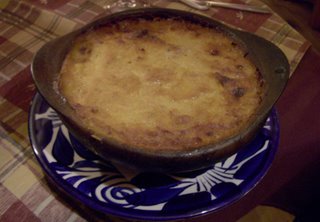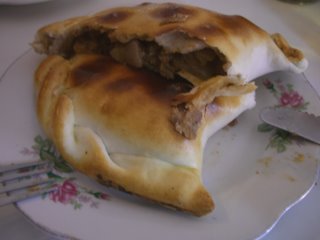
 Bronze Onion leaves at Arzak restaurant (San Sebastian)
Bronze Onion leaves at Arzak restaurant (San Sebastian)
ex chuchuhuasi con gas

 Mastija (se pronuncia asi) es una resina que viene de los arboles con el mismo nombre que solo hay en la isla de Chios en Grecia. Esta resina natural se mastica en su forma de cristal / lagrima o se utiliza en polvo para recetas culinarias o aplicaciones farmaceuticas -medicinales. El chicle mas antiguo del mundo y el unico 100% natural. Ademas la mastija en forma de piedra/cristal es un chicle eterno ya que nunca pierde su sabor y lo puedes masticar mas de una vez porque no se gasta. En la antiguedad, las civilizaciones del Mediterraneo del Este masticaban esta resina solidificada para limpiar sus dientes y obtener un aliento fresco y dulce. Aqui versión pop: Chicle de Mastija de Chios en grageas.
Mastija (se pronuncia asi) es una resina que viene de los arboles con el mismo nombre que solo hay en la isla de Chios en Grecia. Esta resina natural se mastica en su forma de cristal / lagrima o se utiliza en polvo para recetas culinarias o aplicaciones farmaceuticas -medicinales. El chicle mas antiguo del mundo y el unico 100% natural. Ademas la mastija en forma de piedra/cristal es un chicle eterno ya que nunca pierde su sabor y lo puedes masticar mas de una vez porque no se gasta. En la antiguedad, las civilizaciones del Mediterraneo del Este masticaban esta resina solidificada para limpiar sus dientes y obtener un aliento fresco y dulce. Aqui versión pop: Chicle de Mastija de Chios en grageas.

 Ay, la bugácha... Que maravilla de artesanía. El anterior post era sobre el galaktoboúreko, pues bugácha también está rellena de crema, aunque las hay rellenas con queso (Joanita las prefiere asi). Tu eliges la cantidad que quieres, el maestro la trozea, la espolvorea con azúcar y canela (como se ce en la segunda foto) , y calentita se deshace en la boca. En el norte de Grecia, hacer bugátsa es una arte, y aquí una de las mejores. En Xanthi, Tracia en "Nea Anoixi" un local especializado en bugátsa
Ay, la bugácha... Que maravilla de artesanía. El anterior post era sobre el galaktoboúreko, pues bugácha también está rellena de crema, aunque las hay rellenas con queso (Joanita las prefiere asi). Tu eliges la cantidad que quieres, el maestro la trozea, la espolvorea con azúcar y canela (como se ce en la segunda foto) , y calentita se deshace en la boca. En el norte de Grecia, hacer bugátsa es una arte, y aquí una de las mejores. En Xanthi, Tracia en "Nea Anoixi" un local especializado en bugátsa Galaktobúreko (escrito tal como se pronuncia en español) es posiblemente el rey de los dulces para mucha gente en Grecia. Crema fabulosa, rica y consistente. Sobre una fina capa de filo (especie de hojaldre) que también la tapa. Bañado en un almíbar. Pura energía. Uno podría sobrevivir alimentandose exclusivamente a base de esta maravilla. Este ejemplar proviene (y se zampó) de Stáni, en Omónia, Atenas.
Galaktobúreko (escrito tal como se pronuncia en español) es posiblemente el rey de los dulces para mucha gente en Grecia. Crema fabulosa, rica y consistente. Sobre una fina capa de filo (especie de hojaldre) que también la tapa. Bañado en un almíbar. Pura energía. Uno podría sobrevivir alimentandose exclusivamente a base de esta maravilla. Este ejemplar proviene (y se zampó) de Stáni, en Omónia, Atenas. Tengo que admitir que es una representación erótica (cortesía de Francisco) pero en esa imagen se puede apreciar el fast food mas potente del planeta. Souvlaki. Es una religión y ningún tipo de comida rapida importada lo ha podido desbancar del puesto numero 1 en las preferencias de los paladares griegos y gente que ha visitado Grecia. Esta delicia con carne, tomate, cebolla y salsa tzatziki - hay varias configuraciones- envuelto en esta pita suave es para chupar los dedos. Uno de mis preferidos donde la carne es una especie de kebab, es la souvlakería de Stavros, cerca del mercado municipal de Kallithea, Atenas. Erotismo.
Tengo que admitir que es una representación erótica (cortesía de Francisco) pero en esa imagen se puede apreciar el fast food mas potente del planeta. Souvlaki. Es una religión y ningún tipo de comida rapida importada lo ha podido desbancar del puesto numero 1 en las preferencias de los paladares griegos y gente que ha visitado Grecia. Esta delicia con carne, tomate, cebolla y salsa tzatziki - hay varias configuraciones- envuelto en esta pita suave es para chupar los dedos. Uno de mis preferidos donde la carne es una especie de kebab, es la souvlakería de Stavros, cerca del mercado municipal de Kallithea, Atenas. Erotismo.




